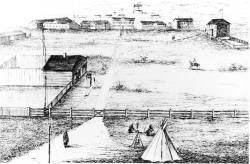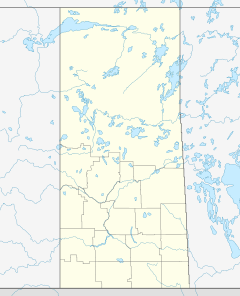Fort Livingstone (Saskatchewan) facts for kids
Quick facts for kids Fort Livingstone |
|
|---|---|

Sketch of Fort Livingstone circa 1877
|
|
| Type | Fort, Military Structure |
| Location | Pelly, Saskatchewan, Canada |
| Nearest city | St. Philips No. 301 |
| Built | 1874 |
| Architect | Department of Public Works (Canada) |
| Governing body | Parks Canada |
| Important events | First capital of the Northwest Territories 1876-1877 Former post of the North-West Mounted Police |
| Website | Parks Canada official website: http://www.pc.gc.ca/eng/lhn-nhs/sk/livingstone/index.aspx |
| Designated | 1923 |
|
Fort Livingstone
|
|
|---|---|
Fort Livingstone was an important early settlement in what is now Saskatchewan, Canada. It was built a long time ago, in 1874. For a short time, it was the very first capital city of the huge Northwest Territories. It also served as a main base for the North-West Mounted Police.
Contents
What Was Fort Livingstone?
Fort Livingstone was built as an "outpost." An outpost is like a small, distant settlement or military base. It was located in a wild area that was just starting to be settled. The fort was important for helping to establish Canadian law and order in the western parts of the country.
First Capital City
From 1874 to 1876, Fort Livingstone was the capital of the Northwest Territories. A capital city is where the government of a region or country meets. This means important decisions about the vast Northwest Territories were made right here. It was a very significant place for a short time.
Home to the North-West Mounted Police
The fort was also the headquarters for the North-West Mounted Police (NWMP). This group was created to bring law and order to the Canadian West. They were the police force of their time. From Fort Livingstone, they worked to keep the peace and enforce laws in the new territories.
Moving On
Fort Livingstone's time as a capital and police headquarters was brief. In 1876, the capital of the Northwest Territories moved to Battleford. The NWMP also moved their main base to Fort Macleod, Alberta. This happened as more people moved west and new settlements grew.
A Place of History
Even though Fort Livingstone was only active for a few years, it played a big role in Canadian history. Because of its importance, it was named a National Historic Site of Canada in 1923. This means it's recognized as a special place that tells an important story about Canada's past. In 1986, it was also made a provincial Protected Area.
The closest town to the old fort site today is Pelly, Saskatchewan.


